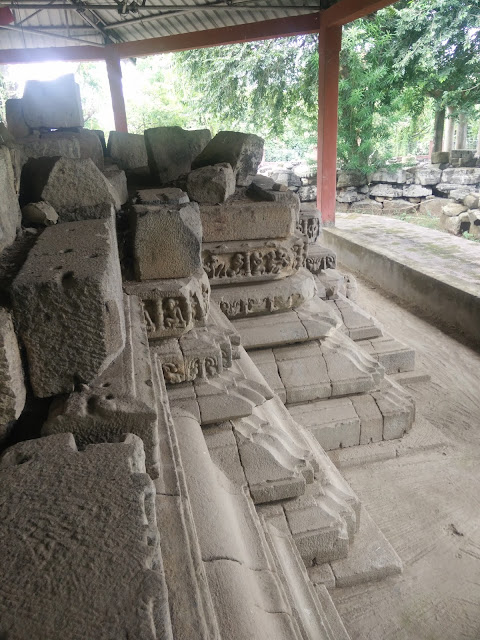Day 2 (28th Oct 16)
The visit of this day started from a visit to Madan Kamdev
temple (ruins). An ancient temple dedicated to Kamdev (god of love) which got
detected in a forest may be a century ago and excavation of the temple happened
only in 1982.
While the tourist literature gives an impression that we would see a grand temple, replica of Khajuraho, etc. When you reach there you realise that it is not so. So what is there?
There is only the base of the temple and Madan Kamdev Murti
(supposedly an idol of Parvati and Shiva (as Uma Maheshwar)
holding each other in embrace but covered by a cloth).
 |
| Climbing up to Temple |
Rest are the
pieces of the temple excavated and arranged in random order in the complex.
There are beautiful carvings of daily life on most of the stones including
explicit sexual act (similar to
Khujaraho).
This temple is believed to be one among the twenty temples in this
area out of which some have been excavated. We need to visualise that once upon a time it must have been a grand temple. If reconstructed, it may yet again be. Despite there are only ruins there, just to see that once upon a time there was something with such beautiful carvings, the place is recommended for a visit.
Our next stop was Sualkuchi village, the silk weaving centre
of NE India where Munga (assam silk), pat or mulberry and Erri silk cloths are
woven. Muga and Erri (Which has warm nature like Wool)cocoons are grown only in Assam.
There are over 13000 looms in this place. Most of the Assam silk (muga) sarees are produced here and are sold all over India.
 |
| Sualkuchi Village Entrance Gate |
There are over 13000 looms in this place. Most of the Assam silk (muga) sarees are produced here and are sold all over India.
Present day looms used in Sualkuchi are handlooms but are
not the basic one. There is some mechanism which uses the punch cards running
in a garland type fashion on top of the loom to
create a design. This reduces manual work a bit in creating a design.
 |
| The Lady on the Job at a Loom |
Most loom owners employ people (though weaving cloth for
home use is common in household in Assam using simple hand loom). They also use
their drawing room (in a local house
there is a room where guests are entertained thus calling it so) as their
showroom but some of the loom owners do have small saree shops on the main
road. Starting with “we will just see but not buy” we looked around, spend
almost 3 hours and since rates looked competitive with added joy of buying
directly from weavers, we ended up buying few sarees.
 |
| Our In house Model in Mekhala Chadar (Assamese Dress) |
Returning to Guwahati and then navigating through killing
traffic we reached our late evening boat cruise area by 1530 and remembered
that we have not had lunch. After a quick lunch we boarded the boat by 1645 (by
which time it was already dusk time). Boat left at 1715 in near darkness.
 |
| The King of Good Time, thats me |
The
cruise was for about 45 minutes. Placid Brahmaputra was charming and we enjoyed
the cruise but felt that it should start early and should be made sunset
cruise, that would be grand. Food and drinks are available on board on payment.
Post cruise it was return to hotel.


























No comments:
Post a Comment